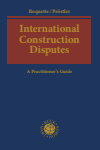International Construction Disputes
A Practitioner's Guide
Zusammenfassung
Construction projects are highly technical long-term projects in which the structure and the shape of the building, road, bridge, plant, or other works is planned and developed on an ongoing basis. They involve many parties, which – although supposedly committed to achieve a common goal – all have their own interests. These and other reasons lead to a high technical, organizational, and legal complexity, which increases the risk of disputes and the need for effective dispute resolution. However, not only construction projects, but also construction disputes and their resolution are highly complex.
The book focusses on the nuts and bolts of these complex construction disputes and their resolution. It covers in its chapters dispute avoidance, alternative dispute resolution, arbitration, litigation, and evidence in construction disputes as well as future trends, such as the digitalized construction site and legal tech in construction disputes. Legal systems have developed different methodologies to deal with disputes. The obvious divide is between the civil law and the common law worlds. While various legal systems have considerably different approaches to construction disputes, they regularly achieve similar dispute resolution outcomes. The book looks on construction disputes from an international perspective, presents different paths to their resolution, and gives insight on the common issues faced on the way.
- Kapitel Ausklappen | EinklappenSeiten
- I–XVII Titelei/Inhaltsverzeichnis I–XVII
- 1–35 Chapter 1: Early Claims Resolution 1–35
- I. Introduction
- II. Effective claims management
- III. Neutral/engineer determination
- IV. FIDIC and NEC claims procedure
- V. Practical issues
- VI. Conclusion
- 35–81 Chapter 2: Alternative Dispute Resolution 35–81
- A. Overview
- I. Choosing the right dispute resolution mechanism
- II. ADR clauses
- III. Multi-party disputes
- B. Adjudication
- I. Introduction
- II. Statutory adjudication
- III. Contractual adjudication
- C. Expert Determination
- I. Introduction
- II. Distinction between expert determination and other forms of ADR
- III. Types of expert determination
- IV. Advantages and disadvantages of expert determination
- V. Scope and limits to the expert’s jurisdiction
- VI. Procedure for expert determination
- VII. Challenge of expert determination
- VIII. Enforcement of expert decisions and interplay with arbitration
- IX. Conclusion
- 81–147 Chapter 3: Arbitration 81–147
- A. Arbitration (Commercial)
- I. Introduction
- II. The arbitration agreement
- III. Applicable laws and rules
- IV. Role of state courts in arbitration
- V. The arbitral tribunal
- VI. The arbitral proceedings
- VII. The award
- VIII. Interim measures and partial awards
- B. Investment Arbitration
- I. Introduction
- II. Investment arbitration as a means of resolving (construction-related) disputes
- III. Fundamental requirements for raising an investment arbitration claim
- IV. Investment arbitration proceedings
- V. Recognition and enforcement of investment arbitration awards
- VI. Recent developments and the future of investment arbitration
- 147–205 Chapter 4: Litigation 147–205
- A. Litigation (National)
- I. Introduction
- II. Construction litigation in civil law jurisdictions
- III. Construction litigation in common law jurisdictions
- IV. The Technology and Construction Court (England and Wales)
- B. International Courts
- I. Introduction
- II. General overview of international commercial courts
- III. International commercial courts
- 205–339 Chapter 5: Evidence in Construction Disputes 205–339
- A. General Principles
- I. Introduction
- II. Fundamental principles of evidence
- III. Means of evidence
- IV. Burden and standard of proof
- V. Proving complex claims
- VI. Applicable law issues and ascertaining the content of the applicable law
- VII. Conclusion
- B. Delay
- I. Introduction
- II. Time aspects
- III. Financial aspects
- IV. Procedural aspects
- C. Quantum
- I. Introduction
- II. Legal bases for the determination of quantum in construction disputes
- III. Typical monetary claims in construction disputes
- IV. Procedural aspects regarding the determination of quantum
- V. Proof of quantum
- D. Expert Evidence
- I. Introduction
- II. Types of specialised knowledge and the corresponding experts
- III. Party-appointed experts
- IV. Procedural aspects concerning party-appointed experts
- V. Tribunal-appointed experts
- VI. Experts recording specific situations of fact
- E. Early Taking/Securing of Evidence
- I. Introduction
- II. Time aspects for securing evidence
- III. Types of evidence
- IV. Institutions and procedures of taking evidence
- V. Selected practical issues
- 339–365 Chapter 6: The Future of Construction Disputes 339–365
- A. The digitalised construction site
- I. Introduction
- II. Electronic documentation
- III. Building Information Modelling (‘BIM’)
- IV. Sensorial and visual documentation
- V. The automated construction process
- VI. Blockchain
- VII. Smart contracts
- VIII. Outlook and conclusion
- B. Legal Tech in Construction Disputes
- I. Introduction
- II. Document and information handling
- III. Demonstration and visualisation
- IV. Assisted decision-making
- V. Outlook and conclusion
- 365–372 Index 365–372


